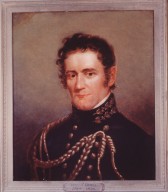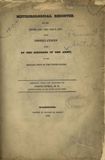Climate Change
The United States Weather Bureau was established within the War Department by an act of Congress in 1870. In addition to providing storm warnings on the Great Lakes and America's coastline, the bureau was responsible for taking meteorological observations at all U.S. military posts throughout the country. Under the Secretary of War, the military continued providing this information until the Weather Bureau was transferred to civilian direction under the Department of Agriculture in 1890. In fact, the military had been systematically recording weather data at its posts since 1820.
In 1820, just two years after being appointed the newly reorganized Army's first Surgeon General, Joseph Lovell believed that the surgeons under his command at America's far-flung military outposts provided him with a unique opportunity. He was familiar with studies in Europe that attempted to measure the effects of population on local climates. The results thus far were conflicting and unauthoritative. As he put it:
While one contends, that as population increases and cultivation extends the climate becomes warmer, another is equally convinced that it becomes colder, and a third, that there is no change in this respect.
In America, however, there was still much unpopulated and uncultivated land, and many military posts were in areas that were on the verge of human development. He believed that keeping meteorological records of these areas would provide invaluable data in support of future conclusions. Weather observations had been kept previously at military stations, but not on a systematic or formal basis. From 1820 until 1870, Army medical personnel kept consistent meteorological records which are now considered a substantial foundation of the nation's historical weather data.
An example of the information provided by Lovell's surgeons: In areas such as Fort Snelling, located near present day Minneapolis, before there were cities or newspapers, there is no other way to know that the thermometer dropped to a low of -25 F during January 1822.
Items from the Surgeon General's Library
Last Reviewed: February 8, 2024


![Meteorological Register data, QC qU56m 1826 - Jan 22 data detail Excerpt from a page in the Meteorological Register for the years 1822, 1823, 1824 & 1825 of a chart with printed information, in black, as follows: January. Places of observation. Thermometer. Winds. Weather. Mean Temperature. VII. II. IX. Average of mean temp. Higher deg. Lower deg. Reg. Range. N., N.W., N.E., E., S.E., S., S. W., W. Prevailing. Fair. Cloudy. Rain. Snow - Prevailing. Days. Days. Days. Days. Days. Days. Days. Days. Days. Days. Days. Days. Fort Snelling 6.58 - 17.54 - 10.93 - 11.68 - 46 - -25 - 71 - 3 - 9 - 1 - [null] - 2 - 7 - 9 - [null] - [null] - 13 - 11 - 2 - 5 - Fair. Fort Sullivan 15.03 - 20.93 - 17.64 - 17.86 - 40 - -9 - 49 - 4 - 9 - 2 - [null] - 1 - 2 - 7 - 6 - N.W. - 14 - 15 - [null] - 2 - Cl'dy. Fort Howard - 7.19 - 18.61 - 13.80 - 13.20 - 53 - -23 - 76 - 2 - 3 - 6 - [null] - [null] - [null] - 20 - [null] - S.W. - 13 - 9 - 1 - 8 - Fair. Fort Crawford - 8.48 - 23.03 - 13.09 - 14.86 - 57 - -19 - 76 - 4 - 14 - 1 - [null] - 3 - 3 - 5 - 1 - N.W. - 15 - 13 - [null] - 3 - Fair. Fort Wolcott - 24.45 - 30.87 - 24.51 - 26.54 - 45 - 0 - 45 - 2 - 13 - 3 - 1 - [null] - 2 - 8 - 2 - N.W. - 20 - 6 - 4 - 1 - Fair. Council Bluffs - 13.00 29.67 - 20.41 - 21.02 - 59 - -16 - 75 - 2 - 14 - 2 - [null] - 3 - 2 - 5 - 1 - N.W. - 22 - 5 - [null] - 4 - Fair. Fort Columbus - 21.00 - 33.45 - 23.96 - 26.17 - 60 - -1 - 61 - [null] - 15 - 1 - [null] - 1 - 7 - 7 - [null] - N.W. - 19 - 11 - 1 - [null] - Fair. Fort Severn - 25.80 - 33.32 - 28.74 - 29.28 - 44 - 8 - 36 - 4 - 11 - 2 - 2 - 3 - 2 - 3 - 4 - N.W. - 17 - 6 - 5 - 3 - Fair. Fort Johnston - 46.64 - 54.25 - 50.09 - 50.32 - 58 - 26 - 32 - 16 - 4 - 1 - 3 - [null] - 3 - 1 - 3 - N. - 17 - 4 - 9 - 1 - Fair. Baton Rouge - 48.03 - 58.03 - 51.06 - 52.37 - 70 - 30 - 40 - [null] - [null] - [null] - 4 - 14 - [null] - 4 - 9 - S.E. - 18 - 5 - 8 - [null] - Fair. Cant. Clinch - 46.57 - 58.83 - 50.16 - 51.85 - 70 - 22 - 48 - 1 - 4 - 15 - 1 - 3 - [null] - 6 - 1 - N.E. - 22 - 3 - 6 - [null] - Fair. Meteorological register for 1822.](./images/QCqU56mdatadetail-t.jpg)

